How to Spend Two Weeks and $1,400 in Thailand
by Maria Aspan
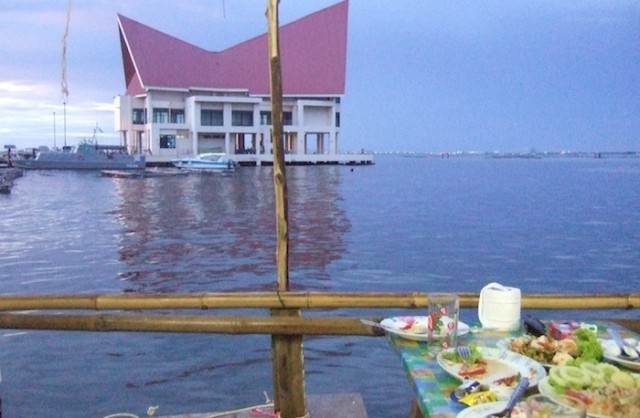
The bill was $65. I blinked, looked down at the pile of crab shells on my plate, and recalculated. There were six of us, sitting cross-legged around a low table next to the sea. There were platters upon platters of shrimp and crab and fish, a fresh-caught mountain of food that would put any New York restaurant’s seafood towers to shame. There were large, sweating bottles of beer that had been replenished several times over the course of two hours. I dropped the zeroes, divided by three, double-checked the trickier-than-it-should-be conversion of baht to dollars and — it was still $65.
That was my second dinner in Thailand this September. I’d have the same discombobulated certainty that there had been a mistake with the check several more times during my two weeks there. The trip started off as a birthday present to myself, a way to mark a new decade by going to a new continent, and my first big vacation to somewhere new in a couple of years. It also turned into a well-timed escape. I left behind the muddy end of a long relationship, a break I’d been mourning months in advance. While I wasn’t expecting Elizabeth Gilbert-level catharsis, I was looking forward to being eleven hours ahead of New York and as far away as possible from its relentless Internet access.
I convinced my friend Audrey to come with me, escalating our tradition of celebrating our August birthdays by buying ourselves an extravagant meal at some Michelin-starred restaurant. Her mother grew up in Thailand, and most of that immediate family still lived there, but Audrey hadn’t returned to visit since college. When we left New York, we had an invitation to stay for a few days with Audrey’s aunt and uncle near Bangkok, and an offer to look up another aunt in Chiang Mai.
Since getting back, I’ve told friends to go to Thailand because while the flight might be expensive, everything else is dirt-cheap. Neither of those statements were technically true for me — I got my flight for free with long-accumulated credit card miles, and occasionally used that as an excuse to splurge elsewhere.
Some of our biggest expenses were internal flights, since we decided to spend money rather than time traveling around the country. And while we had several $1 bowls of noodle soup, we also lapsed into paying New York prices for dinner a couple of times, when the inescapable spiciness had shaken our stomachs and we just wanted pizza and green salad and a bottle of wine, thank you very much. (I probably should have foodie tourist guilt over that resort-town dinner, but I don’t; it was really good pizza and green salad and wine, and exactly what we were craving after fish ball soup and duck’s web dumplings and pig’s blood broth. I loved most of the Thai food we tried, but not all of it.)
So I spent more money than I could have, but I don’t regret it. I could afford it; I’d been saving in advance, and my parents gave me some money towards the trip for my birthday. I paid off my credit card bill in full last month, as always. We saved on a couple of big expenses upfront, and we were also spoiled by Audrey’s relatives, who took us around parts of the country I never would have found through Lonely Planet and who refused to let us pay for anything more than the odd lunch or $1.60 water taxi fare.
I paid for most of the flights upfront, Audrey paid for some of the hotels, and we took turns covering expenses while we were there, mostly depending on who had more baht on hand. I tallied everything on an iPhone “note” file, using a system that had worked pretty well for us when we traveled to Paris together last year: With the exception of souvenirs and the odd snack, which I didn’t record, our purchases were pretty communal — we ordered family-style at meals, drank at about the same rate, and did the same activities during the day. (The Paris trip was also good for figuring out that we were compatible travel buddies.) The file is full of entries like: “Thurs Sept 6: Maria 600 baht for 2 massage, Audrey 100 for tuk tuk, Maria 300 for dinner.” When we got home, Audrey made a spreadsheet of all our spending, determined that I’d spent more on our joint expenses, and gave me a check for the difference. From door to door over 17 days, we spent a combined $2820.98, or $1410.49 each, at about 30 baht to the dollar. That included elephant rides and cooking classes and river cruises, but also tips, “tuk tuk” taxis, mango sticky rice, and “Thai whiskey,” which is actually rum. Here are some of our more interesting expenses:
Roundtrip plane ticket to Bangkok: $83.20 (priced at $1385.60). Probably the best deal of the trip, I got my plane ticket for free with credit card rewards points, plus $83.20 in fees and taxes. The ticket wiped out about half of the points I’ve accumulated over four years of using my credit card for everything I can, from Starbucks and taxis to groceries and restaurant meals. It works for me as a budgeting tool — I pay for my entire bill every month, and while having it is sometimes a temptation to spend more than I should, I also notice when my monthly bill is higher than usual and cut back accordingly. I’ve been saving up my rewards points for a big international ticket like this, but the card also gives me some side perks. like free checked bags and early boarding and all of those second-tier things that shouldn’t actually be luxuries while flying but are. I do pay an annual fee of about $100 for the card, but since I check bags more than four times a year, it pays for itself.
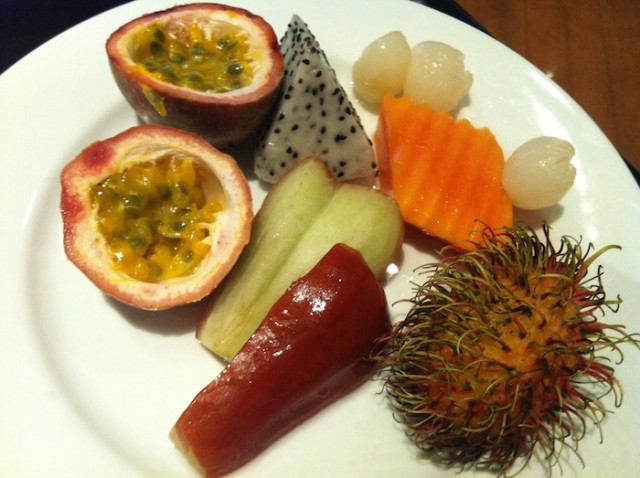
Plaza Athénée, Bangkok, 2 nights: $256.46 or $64.12 each per night. We picked this hotel somewhat blind from the deluge of suggestions on Trip Advisor, Expedia, booking.com et al — we just wanted somewhere clean and comfortable in a decent area, that we could stumble to after our midnight arrival in Bangkok, after spending 22 agonizing hours flying through coach-class time zones. The hotel was all of those things, while being somewhat corporate, and also the sort of place where we passed older European men escorting younger Thai companions up to their rooms. But it was worth the price (and seeing some of those couples’ mornings-after) just for its Olympic gold medalist of free breakfast buffets. There were fruits with prickly spines that looked ready to crawl off my plate and attack; there were fresh juices in neon shades; there were eggs and congee and dim sum and pastries and noodles and spinach salad.
Much later, the hotel bar was empty save for one gentleman, an enthusiastic lounge singer, and their flirtation. Maybe we chased him away; once he left, the singer turned to us after every song, looking for requests, her exasperation mounting as my jet-lag-addled brain ran dry of all but a few tracks on my Louis Armstrong-Ella Fitzgerald compilation. The singer eventually gave up on us, but not without venting her frustration; her next song was a very energetic version of Meredith Brooks’ “Bitch.” (Two Mai Tais, one Singapore Sling and one glass of wine, $48, including automatic tip; passive-aggressive lounge singer serenade, priceless.)
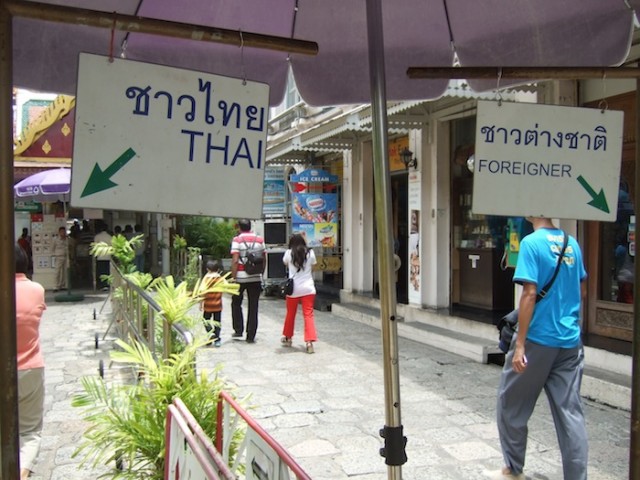
“Foreigner” fees in Bangkok: $8.33 each, including one bottle of “special for tourists” water. On our first full day in Bangkok, Audrey’s Aunt Tim and cousin Aum (nicknames for their full, multisyllabic Thai names) picked us up and took us to some of the mandatory tourist sites, including the royal family’s Grand Palace and the Wat Pho temple. This is where we first encountered the entertaining racial profiling that goes on at many Thai tourist destinations: “Free for Thai. Foreigner, go pay $3.” Besides signs to this effect, the enforcement consisted of a couple of palace guards sitting between two gates, sizing up the ethnicity of entrants, and pointing them to one line or the other depending on who looked like a native. At the Grand Palace, Audrey almost got flagged through the Thai line, even though her mother is ethnically Chinese and her father is Italian-American, but my pasty face got us sent back to the ticket window. At Wat Pho, we got the consolation of a “special for tourists” bottle of water with our ticket. Weird concentration-camp overtones notwithstanding, I kind of love this system. I wish that MoMA and other New York museums would adopt a similar (if profiling-free) pricing policy for residents and tourists.
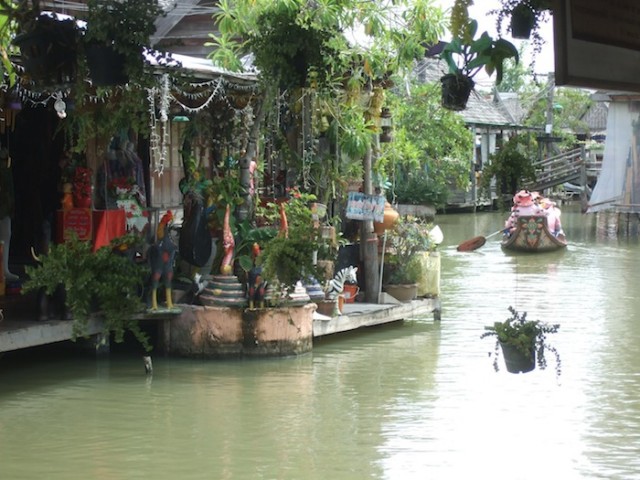
Three days in Sriracha, at Audrey’s relatives’ guest house: Free; or a series of days spent fighting, unsuccessfully, over the dinner check. Tim, her husband Charles and their two adult children live in the Chonburi region, about an hour’s drive past Bangkok’s terrifying traffic. Staying with them was possibly my favorite part of the trip — Chonburi may not be the most beautiful part of Thailand, but it was still pretty beautiful, and Audrey’s relatives spent three days playing host and guide and driver to make sure that we saw floating markets and island temples and monkey parks and riverside nature preserves. On Labor Day, we spent the day on Bang Pakong river, on Charles’ brother’s boat, stopping off to buy crabs and prawns from fishermen who wrapped the pincer claws in bright red gift ribbon. Charles, who’d found out at dinner the night before that I would drink beer, kept on pressing fresh cold cans into my hands while we skimmed down the river. The rain came as we sat in yet another open-air restaurant, our fishermen purchases delivered to the kitchens and returned, cooked and cracked open and accompanied by tingling purees of chilis and herbs. And we weren’t allowed to pay for any of it. Tim and Charles would let us buy lunch — six bowls of duck noodle soup on the island of Koh Sichang were 230 baht, or $7.67 total — but our every effort to catch the dinner checks failed. We hoped that our hostess gifts, of American candy bars and New York-themed dish towels from Fishs Eddy, showed our gratitude in some small way.
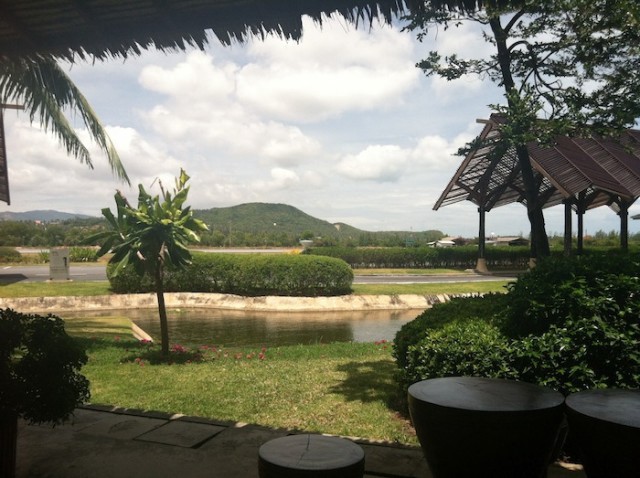
Internal flights from Bangkok to Chiang Mai to Koh Samui to Bangkok: $939.61 for six tickets, or $469.81 each. The $73 airline tickets I found to Chiang Mai were our gateway drug to spending money on internal flights. They were only $20 more than tickets for the overnight train, which took ostensibly 12 hours instead of the 90-minute plane ride on no-frills Air Asia. (We later met tourists who told us their trip on that train had taken about 16 hours.) We couldn’t find budget airline tickets for the rest of our internal flights and wound up paying a couple of hundred dollars each for Bangkok Airways flights. But those tickets, which cost about the same as cheap domestic U.S. fares, turned out to be luxuries. The Bangkok Airways flights included access to a business-class-like lounge with food and lemonade and free wifi. Leaving the island of Koh Samui, the open-air lounge’s couches were surrounded by palm trees, while the women’s bathroom had a wall-sized fishtank. Best of all, flying Bangkok Airways introduced us to the most bizarre in-flight safety video of all time. In case you’ve now forgotten the Macarena, Bangkok Airways’ flight attendants have you covered:
Fresh coconuts, 60 cents to $1.33 each. “We’re forming expensive habits,” Audrey said a couple of times during the trip, after yet another seafood feast or $10 massage. But what I miss the most are the fresh coconuts. I’ve had them before, mostly in beach towns, but in Thailand they’re the equivalent of New York hot dogs. We had them from roadside stalls during long drives, from lunch counters in the middle of Bangkok, from shops in the Pattaya floating market. Sucking out the guts of so many freshly-chopped coconuts had the unfortunate side effect of making me actually like coconut water, which had always tasted soapy when I tried Vita or Zico before. But now I find myself spending $3 or $4 every week after yoga, to satisfy a craving for what really can’t taste the same out of its shell.
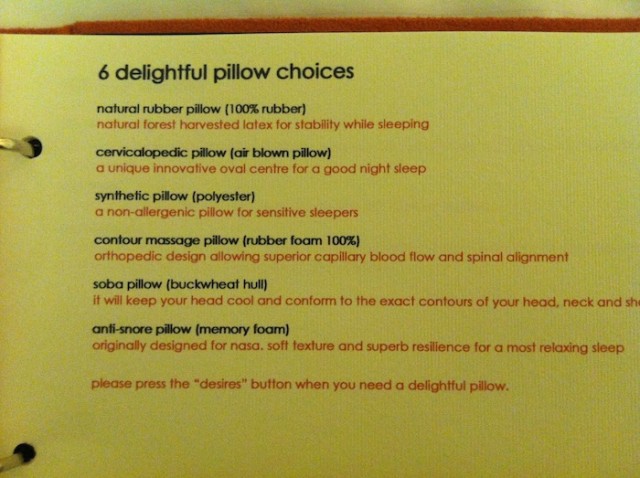
Dusit D2 hotel, Chiang Mai, five nights: Free, in exchange for another chunk of my airline miles. The Delta website has this wonderful and unadvertised section that lets you redeem miles in exchange for hotel stays — I found it randomly this summer while looking at tickets, and it offered everything from the Mandarin Oriental to backpacker hostels. The Dusit was somewhere in the middle, trying very hard to replicate a Lower East Side boutique hotel in north Thailand, stuffed between the souvenir stands of the Chiang Mai night bazaar and the hostess bars of a red-light district. The friendly, mostly-male hotel staff dressed in baggy black pants, Converses, and white Oxfords with orange suspenders. Everything was decorated in creams and browns with bright orange accents, including the perfectly round pillow the housekeepers kept leaving on Audrey’s bed and the orange plastic cube where they left nightly treats, like durian-flavored candy. The booklet in our room offered us a choice of rubber or buckwheat pillows, and we reached the receptionist by calling the “Desires” hotline, but the overall effect was somehow charming rather than creepy. Every time we left, a staff member presented us with large orange umbrellas to guard against the rainy days of Chiang Mai; every time we returned, a security guard would walk us back inside under the shelter of a stretching beach umbrella.
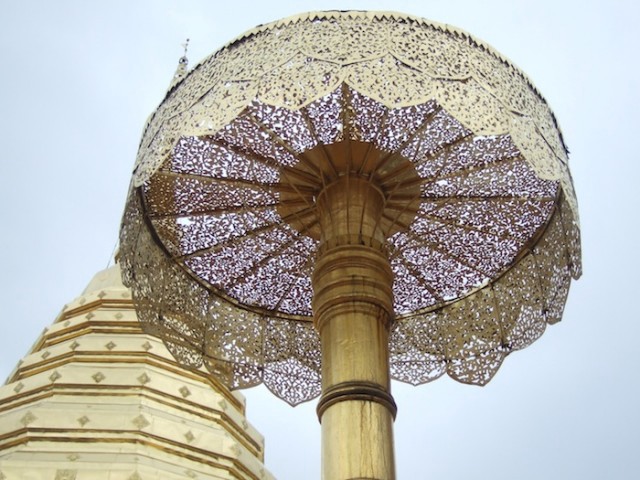
Tipping: Varied. Wildly. Figuring out how much to tip is always one of the most stressful parts of traveling abroad for me, especially when it’s to a place like Thailand, which has pockets of enormous poverty and where even people who are pretty well-off would qualify as members of our 99%. And here I’m paying $20 for what seems like a feast, or for a spa visit that would cost hundreds of dollars in New York, and all the available information says to leave a few cents, if anything? In Chiang Mai, Audrey’s Aunt Bibi took us to her favorite Thai massage spa ($10 each for about 75 minutes of pounding and stretching and toe-cracking). When we paid, the receptionist tried to stop us from leaving tips of 100 baht — or about $3 — for each of our masseurs. “Enough, enough!” she said.
There’s a dueling impulse, especially when you think of yourself as a tourist who disdains packaged tours and wants to learn what the “real” country visited is like — you don’t want to be a rich-yet-stingy American, but you also don’t want to look like an unsophisticated traveler who throws money around without paying attention to local customs. Which is silly, really, but insidious. When I first got to Thailand, I didn’t want to feel like I was being taken advantage of by the hustlers who all make so, so much less than I do. By the end of the trip, I felt ashamed for worrying about that. I’m glad we each left 100 baht for the massage therapists. I hope the receptionist gave it to them.
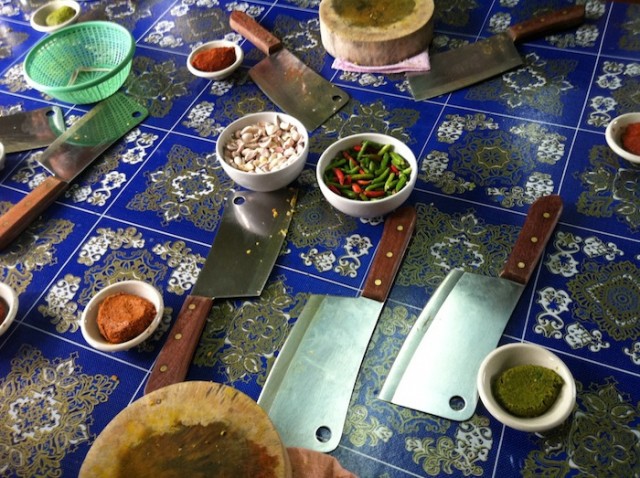
Siam Rice Thai Cookery school, “half day” class for $23.33 each. This was one of our more touristy days, but also one of my favorites. Our group of nine students was entirely Anglophone, with one French exception, but the class gave me an appreciation for all of the food we’d been eating throughout the visit. We started with a tour through a local market, so that we could see and smell the vegetables and herbs and fifteen different kinds of basil we were about to whack and pound into curry pastes. I remembered the one other cooking class I took in New Jersey a couple of years ago, for a friend’s birthday party, when we each paid about $100 for three hours with an instructor who visibly loathed working on a Sunday evening. Nancy, the owner and teacher at Siam Rice, was friendly and funny and handed out her email address while her young son ran around the dining room. The rain pounded on the eves of the open-air kitchen, the woks smoked and burst into flame, and our group sat around a table tasting each other’s curries and trading stories of our intersecting, diverging vacations.
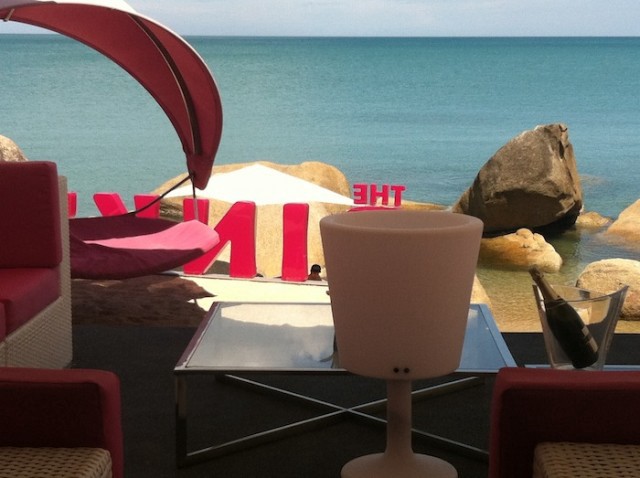
Dinky Rock, Koh Samui, $514.53 for four nights, or $64.32 per person per night, plus “Dinky Bonuses.” Going to Thailand during the rainy season helped us justify part of our splurging on nicer hotels, including this one. Audrey found the Dinky — “Double Income No Kids Yet” — which professed to be a boutique, adults-only resort for couples and groups of friends. It wasn’t all-inclusive, but our rainy-season “Dinky Bonus” package did include more massive breakfasts, a free taxi from the airport and one four-course dinner for two that was the best meal we had on the island. The hotel had its quirks, including glass doors on all of the rooms that were supposedly opaque in daytime (not completely, it turned out!), and we ended up feeling like we were intruding on several honeymoons. But happy couples could be ignored. I opened my Kindle and spent most of the next few days in a beach chair next to the Gulf of Thailand, trying to decide if I preferred kiwi or passionfruit daiquiris ($8 each). By the end of four days, I was almost resigned to going back to New York.
Maria Aspan is the national editor for American Banker. She writes about movies, science fiction and bad Jane Austen covers on her blog.
Support The Billfold
The Billfold continues to exist thanks to support from our readers. Help us continue to do our work by making a monthly pledge on Patreon or a one-time-only contribution through PayPal.
Comments